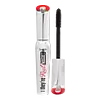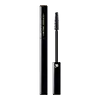Benefit Cosmetics They're Real! Magnet Extreme Lengthening Mascara Versus Lancôme Définicils High-Definition Mascara
What's inside
What's inside
 Key Ingredients
Key Ingredients

 Benefits
Benefits

 Concerns
Concerns

 Ingredients Side-by-side
Ingredients Side-by-side

Water
Skin ConditioningCera Alba
EmollientParaffin
PerfumingPolybutene
Vp/Eicosene Copolymer
Glyceryl Stearate
EmollientAcrylates Copolymer
Copernicia Cerifera Wax
Steareth-21
CleansingPalmitic Acid
EmollientPvp
Emulsion StabilisingStearic Acid
CleansingSilica
AbrasivePentylene Glycol
Skin ConditioningPhenoxyethanol
PreservativeSteareth-2
EmulsifyingAminomethyl Propanediol
BufferingCaprylyl Glycol
EmollientPanthenol
Skin ConditioningHydroxyethylcellulose
Emulsion StabilisingAluminum Hydroxide
EmollientTocopheryl Acetate
AntioxidantDisodium Phosphate
BufferingSodium Phosphate
BufferingPolysorbate 60
EmulsifyingCI 19140
Cosmetic ColorantCI 42090
Cosmetic ColorantCI 77007
Cosmetic ColorantCI 77163
Cosmetic ColorantCI 77288
Cosmetic ColorantCI 77289
Cosmetic ColorantCI 77491
Cosmetic ColorantCI 77492
Cosmetic ColorantCI 77499
Cosmetic ColorantCI 77510
Cosmetic ColorantCI 77742
Cosmetic ColorantCI 77891
Cosmetic ColorantWater, Cera Alba, Paraffin, Polybutene, Vp/Eicosene Copolymer, Glyceryl Stearate, Acrylates Copolymer, Copernicia Cerifera Wax, Steareth-21, Palmitic Acid, Pvp, Stearic Acid, Silica, Pentylene Glycol, Phenoxyethanol, Steareth-2, Aminomethyl Propanediol, Caprylyl Glycol, Panthenol, Hydroxyethylcellulose, Aluminum Hydroxide, Tocopheryl Acetate, Disodium Phosphate, Sodium Phosphate, Polysorbate 60, CI 19140, CI 42090, CI 77007, CI 77163, CI 77288, CI 77289, CI 77491, CI 77492, CI 77499, CI 77510, CI 77742, CI 77891
Water
Skin ConditioningParaffin
PerfumingStearic Acid
CleansingTriethanolamine
BufferingCera Alba
EmollientAcacia Senegal Gum
MaskingPalmitic Acid
EmollientCI 77499
Cosmetic ColorantCopernicia Cerifera Cera
EmollientCI 77007
Cosmetic ColorantSimethicone
EmollientSodium Polymethacrylate
Emulsion StabilisingSilica
AbrasiveMyristic Acid
CleansingHydroxyethylcellulose
Emulsion StabilisingPanthenol
Skin ConditioningPolyquaternium-10
BHT
AntioxidantImidazolidinyl Urea
PreservativeMethylparaben
PreservativePropylparaben
PreservativeWater, Paraffin, Stearic Acid, Triethanolamine, Cera Alba, Acacia Senegal Gum, Palmitic Acid, CI 77499, Copernicia Cerifera Cera, CI 77007, Simethicone, Sodium Polymethacrylate, Silica, Myristic Acid, Hydroxyethylcellulose, Panthenol, Polyquaternium-10, BHT, Imidazolidinyl Urea, Methylparaben, Propylparaben
 Reviews
Reviews

Ingredients Explained
These ingredients are found in both products.
Ingredients higher up in an ingredient list are typically present in a larger amount.
Cera alba is beeswax, or the wax used by bees to make honeycombs. It is a texture-enhancer and emollient. A study from 2003 found beeswax to be a stronger emollient than ingredients such as petroleum jelly.
As an emollient, beeswax helps hydrate the skin by creating a barrier on top. This barrier traps moisture in.
Emulsifiers help prevent ingredients from separating. This helps create consistent texture.
The structure of beeswax is mainly long-chain alcohols and the esters of fatty acids.
There are three types of beeswax: yellow, white, and absolute. Yellow is pure beeswax taken from the honeycomb. White beeswax is created by filtering or bleaching yellow beeswax. Absolute beeswax is created by treating beeswax with alcohol. Beeswax used in cosmetics are purified.
Beeswax has been used throughout history and even in prehistoric times. Some common uses for beeswax still used today are making candles, as a waterproofing agent, and polish for leather.
Learn more about Cera AlbaThis pigment is called Ultramarine blue lazurite. It gives a saturated blue color, but can be used to create other colors as well.
According to the manufacturer, it is usually made from kaolin, sodium sulfate, sodium carbonate, sulfur, and charcoal.
Ci 77499 is also hydrated iron III oxide. It is created from mixing red and black iron oxides. This helps give shades of darkness to a product.
Iron III oxides are classified as inorganic chemicals for coloring.
Hydroxyethylcellulose is used to improve the texture of products. It is created from a chemical reaction involving ethylene oxide and alkali-cellulose. Cellulose is a sugar found in plant cell walls and help give plants structure.
This ingredient helps stabilize products by preventing ingredients from separating. It can also help thicken the texture of a product.
This ingredient can also be found in pill medicines to help our bodies digest other ingredients.
Learn more about HydroxyethylcellulosePalmitic Acid is a fatty acid naturally found in our skin and in many plant and animal sources. In cosmetics, it is usually derived from palm oil. It serves many purposes in skincare, acting as a cleanser, emollient, and emulsifier.
As an emollient, palmitic acid helps soften and smooth the skin by preventing water loss. In cleansers, it helps remove oil and dirt while creating foam.
Its emulsifying properties help stabilize products by keeping water and oil-based ingredients from separating.
This may not be suitable for fungal acne-prone skin, as fatty acids like this can sometimes trigger breakouts in sensitive individuals.
Learn more about Palmitic AcidPanthenol is a common ingredient that helps hydrate and soothe the skin. It is found naturally in our skin and hair.
There are two forms of panthenol: D and L.
D-panthenol is also known as dexpanthenol. Most cosmetics use dexpanthenol or a mixture of D and L-panthenol.
Panthenol is famous due to its ability to go deeper into the skin's layers. Using this ingredient has numerous pros (and no cons):
Like hyaluronic acid, panthenol is a humectant. Humectants are able to bind and hold large amounts of water to keep skin hydrated.
This ingredient works well for wound healing. It works by increasing tissue in the wound and helps close open wounds.
Once oxidized, panthenol converts to pantothenic acid. Panthothenic acid is found in all living cells.
This ingredient is also referred to as pro-vitamin B5.
Learn more about PanthenolParaffin is a solid created from petroleum. The term 'paraffin' can also refer to either
petroleum jelly or mineral oil.
It has natural occlusive properties which can worsen oily skin. Due to its petrolatum base, this ingredient is not fungal-acne safe.
Silica, also known as silicon dioxide, is a naturally occurring mineral. It is used as a fine, spherical, and porous powder in cosmetics.
Though it has exfoliant properties, the function of silica varies depending on the product.
The unique structure of silica enhances the spreadability and adds smoothness, making it a great texture enhancer.
It is also used as an active carrier, emulsifier, and mattifier due to its ability to absorb excess oil.
In some products, tiny microneedles called spicules are made from silica or hydrolyzed sponge. When you rub them in, they lightly polish away dead skin layers and enhance the penetration of active ingredients.
Learn more about SilicaStearic Acid is a fatty acid. It is an emollient, emulsifier, and texture enhancer.
As an emollient, stearic acid helps soften skin. It aids the skin's protective barrier by preventing water loss. It also provides a gentle cleansing effect without stripping away natural oils.
Stearic acid may also be used to enhance the texture of products. It can add volume and stabilize ingredients such as water and oil. This can help water and oil ingredients from separating.
Sources of stearic acid include animal or vegetable fats/oils such as coconut or shea. It can be naturally found in butter, cocoa butter, shea butter, vegetable fats, and animal tallow.
This ingredient may not be Malassezia folliculitis, or fungal-acne safe.
Learn more about Stearic AcidWater. It's the most common cosmetic ingredient of all. You'll usually see it at the top of ingredient lists, meaning that it makes up the largest part of the product.
So why is it so popular? Water most often acts as a solvent - this means that it helps dissolve other ingredients into the formulation.
You'll also recognize water as that liquid we all need to stay alive. If you see this, drink a glass of water. Stay hydrated!
Learn more about Water